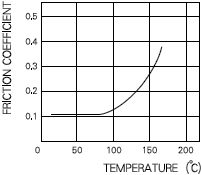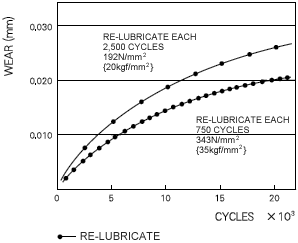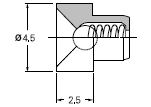Lubrication
Fluid lubrication and Boundary lubrication
It is known that there are fluid type and boundary type lubrications. Minebea's self-aligning bearings are often utilized under high load (surface pressure of 49N/mm2 {5kgf/mm2} or over), and therefore, boundary lubrication is often applied.
With boundary type lubrication, avoiding metal contact is almost impossible, and therefore, the friction coefficient is greater than at fluid lubrication. In addition, the lubricant film developed on the rotating surface may demolish under harsh friction conditions. Insufficient oil flow creates a low cooling effect, and raising temperature could lower the lubrication viscosity. This effect makes the lubricant film to become thinner and eventually distracted. After lubricant film distraction, metal to metal contact occurs, and friction creates wear and possibly seizure as well. With boundary lubrication, continuous friction weakens the lubricant film and moreover, it increases the friction. Thus repairing the lubricant film by re-lubricating is the crucial fact in order to prevent seizure. Under severe application conditions, bearings with oil groove and frequent re-lubricating are both effective.
Figure 17: Friction Coefficient and temperature

Figure 18: Wear of heavy duty bearing with Be-Cu Ball & Stainless Race

Compared to the rotational movement, oscillation movement is a very harsh condition for bearings to perform, and therefore abrasion and seizure is more likely to occur. Oscillation movement contrives very concentrated pressure on a particular part of the ball surface, which creates partial abrasion. Also the lubricant film is broken down with each reversal of the movement direction. The alternating load condition accelerates the grease fluidity, and therefore there is less seizure occurrence than under the uni-directional load. Chrome plated balls are an effective prevention against abrasion and seizure. Chrome itself is a very hard metal with which hardly any wear occurs. Since its oxide film has an excellent strength, metallic bond of race material and chrome rarely exists. The hard bright chrome plating advances mat and dull type plating. The surface roughness influences abrasion and seizure greatly. Especially rough surface of very hard ball material can cause the adhesion of ball abrasion powder on inner race, which eventually causes wear of ball surface.
Grease
Grease is a solid or semi solid lubrication substance, which is a mixture of lubrication fluid and thickener. Occasionally it is provided with additives to improve special characteristics. Lithium soap is most commonly used as a thickener. Soap molecules form narrow fibrous crystals and spread in oil. It is considered that these narrow fibrous crystals are intertwined and construct net-like forms, and that oil enters in between net. Grease itself does not change its form but requires some outer force, and when this outer force is greater than molecules bounding force, grease begins to flow. The greater the outer force, the higher is the fluidity. The grease's apparent viscosity becomes closer to base oil viscosity. However, after a certain point, outer force distracts the fibrous particles, and the grease remains in the same condition even after the outer force has been removed. This condition is called grease structural destruction.
Table 17 shows various grease types that are applicable to metal/metal types.
As described before, grease normally deteriorates under ordinary usage. Without being used, however, after a certain period of storing, grease also deteriorates. The life span of grease depends on the manufacturer, but it is said to be two years in average.
| Grease | Temperature range | Characteristics |
|---|---|---|
| MIL-PRF-23827 | - 73 ~ + 121 ℃ | Generally used for Aircraft application Good water resistance and load capacity (light brown) |
| MIL-G-21164 | - 73 ~ + 121 ℃ | MoS2 added grease. Shows higher load capacity than MIL-PRF-23827. Added MoS2 reduces seizure even where proper lubrication is impossible (dark gray) |
| MIL-PRF-81322 | - 54 ~ + 177 ℃ | Good high temperature stability and low wear rates (light brown) |
| Shell Alvania S2 | - 23 ~ + 121 ℃ | Good general industrial grease (light brown) |
| Shell Alvania RA | - 40 ~ + 130 ℃ | Good low temperature characteristics Good for high frequency oscillation (light brown) |
Lube Fitting
Metal/metal type Rod End are provided with several types of lube fitting as shown in Table 18. Lube fittings are used for re-lubrication which is done by lubricating gun.
| Fitting Type | Characteristic and application | Specification code | |
|---|---|---|---|
| PB101 |  |
|
FN |
| B611 |  |
|
F |
| A-M6F |  |
|
FAS |
Dry-film lubricant
Dry-film lubricant is a solid lubricant. It is applied on a metal surface as a thin film, which helps to prevent corrosion and seizure. Dry-film lubricants are usually made up of molybdenum (MoS2) or graphite mixed with an organic or inorganic resin. The inorganic resin is especially useful where high temperature and high humidity applies. MoS2 is very stable under high temperature or vacuum conditions, and its friction coefficient is extremely low. This explains that the structure of molybdenum is stratified and easy to be distracted. Graphite has also a stratified formation, however its lubricating capacity drops dramatically in the vacuum condition. It is considered that water vapor and/or vapor adsorption layers provide the lubricating capacity, which are not available in the vacuum condition. Dry-film lubrication is suitable for conditions exceeding the grease operating temperature. However, when load is heavy enough to cause bearing deformation, the load distribution is not even, and abrasion of dry film may occur partially. On an oscillating surface, the friction coefficient of dry film is 0.05~0.15. The heavier the load, the lower is the friction coefficient. The storage method shall be carefully considered. Otherwise especially oil or other fluid may easily damage the dry film. It is recommended to carefully choose the most suitable dry-film types.
| Dry-film | Temperature range | Characteristics (Bonding substance) |
|---|---|---|
| 9002 | - 68 ~ + 204 ℃ | MoS2 Common dry film (Epoxy) |
| # 811 | - 185 ~ + 400 ℃ | MoS2 + Graphite Good under both extremely high and low temperature (Water glass) |
| C-200 | - 29 ~ + 400 ℃ For Anti-Seizing + 1315 °C MAX |
MoS2 + Graphite + lead oxide Good under extremely high temperature and resisting corrosion (Silicon compound) |
Related page
Engineering Information for Rod End Bearings
Technical Data
Contact Us
Please click the inquiry type below according to your question. Each product / sales representative will respond to you.